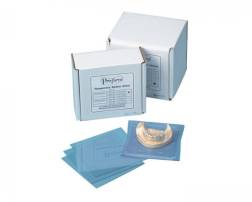-
 CLEAR SPLINT MATERIAL
CLEAR SPLINT MATERIAL
Splint Material
- Purpose: Splints are used to treat temporomandibular joint (TMJ) disorders, bruxism (teeth grinding), or to stabilize the teeth after certain dental treatments.
- Material: Splint materials are typically made from rigid acrylic, polycarbonate, or thermoplastic materials. They are durable and designed to provide a stable, protective barrier for the teeth, often covering all or part of the dental arch.
- Characteristics: Splints tend to be stiffer and thicker to provide proper stabilization and protection.
Aligner Sheets
- Purpose: Aligner sheets are used to create clear aligners (like Invisalign) that are designed to gradually move teeth into better alignment over time.
- Material: Aligner materials are typically made from clear thermoplastic materials such as smart plastics or polyurethane (e.g., Zendura, SmartTrack). These materials are flexible, allowing for gradual tooth movement.
- Characteristics: Aligners are thinner, more flexible, and more transparent than splints. They are designed to fit snugly over the teeth and be worn for extended periods to apply gentle pressure on the teeth.
Key Differences:
- Flexibility: Aligner sheets are more flexible than splint materials.
- Function: Splints are used for stabilization, protection, or pain relief, while aligners are used for orthodontic treatment to move teeth.
- Material: Aligner materials are generally more transparent and flexible, while splints are more rigid and opaque.
So, while both splints and aligners may be made from thermoplastic materials, they serve different purposes, and the materials are formulated to meet those specific needs.




